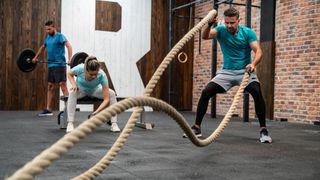How To Improve Grip Strength
Grip strength is one of the best ways to test your overall health

Have you ever noticed your hands slipping off the barbell when you’re attempting a heavy deadlift, or found that your hands and forearms get fatigued during a long bike ride? This might be a sign of poor grip strength.
Grip strength is often neglected both by people who lift weights and endurance athletes. But not only could it improve your performance, it’s also an indicator of overall good health.
In fact, grip strength has been described as a biomarker of aging, which means it’s a medical sign of pathology and body function that provides an objective indication of your health, especially for older adults.
A 2019 review published in Clinical Interventions In Aging found that grip strength can predict a range of health factors including generalized strength and function, bone mineral density, nutritional status, depression and mortality, among other components of health. A four-year study of more than 140,000 adults, published in The Lancet, found that grip strength was “a stronger predictor of all-cause and cardiovascular mortality than systolic blood pressure”.
So there is some science behind the importance of a firm handshake. And although this doesn’t mean you need to dedicate an entire day of training to your hands and forearms, we often forget just how important the use of our hands is, in exercise and in daily life.
How is grip strength measured?
“Grip strength is usually measured with a dynamometer that you squeeze, which will give you a rating in Newton meters or pounds,” explains Jeff Hoobler, strength and movement specialist at Wahoo Sports Science.
This test is based purely on strength and how hard you can squeeze the dynamometer but endurance is also an important part of grip strength, particularly for sportspeople.
There’s no exact measurement to define good grip strength but a 2014 study published in the Journals Of Gerontology defined weak grip strength as less than 26kg (57lb) for men and less than 16kg (35lb) for women.
Who needs good grip strength?
Grip strength comes into play in many sports, such as rugby and tennis. “In rugby, for example, how hard you can hold on to a jersey is quite important, and in tennis, if you can’t hold your racket or if it’s moving, then that’s quite a big factor,” Hoobler says.
Grip strength is important for weightlifting too, whatever level you’re at. “For upper-body moves, including pulling and pushing, as well as power moves, it’s absolutely imperative to have good grip strength,” Hoobler says.
There’s limited research to show exactly how much of an impact grip strength has on lifting, but a recent study looking at 164 athletes participating in the 2022 World Master Weightlifting Championships, focusing on Olympic-style weightlifting, found that good grip strength was associated with better snatch performance.
Working on grip strength is also very important if you’ve had a hand or wrist injury that means your mobility and strength in this area are now limited.
How To Improve Grip Strength
If you’re regularly participating in a sport or activity that requires good grip strength, like any of the ones mentioned above, it will naturally improve over time. But there are a few extra things you can do to work on your grip strength.
For a start, you can buy grips to make dumbbells and barbells thicker, which will increase the amount of work your forearms have to do.
Get the Coach Newsletter
Sign up for workout ideas, training advice, reviews of the latest gear and more.
Hoobler also recommends exercises like pull-ups, along with variations with different grips such as chin-ups, to improve grip strength. Rope climbs and battle ropes are also good ways to engage grip strength.
Most upper-body movements will improve your grip strength, but especially forearm exercises. You could also try climbing and bouldering to improve grip strength, and reap the other benefits of indoor climbing too.
But you don’t have to go to the gym to work on your grip strength. “Squeezing a ball, like a tennis ball or a soft ball, will help you improve your grip strength,” Hoobler says.
There are also a few things you might be doing currently that are limiting your grip strength. For example, using wrist straps when deadlifting means you don’t need to engage your grip strength, so try to avoid this unless you’re maxing out.
“When you’re doing any lift that is approaching maximal, you want to make sure that the muscles you’re trying to train are the ones that are failing, rather than the contact point of grip,” Hoobler says. Wrist wraps are sometimes useful, but using them all the time could have a negative impact on grip strength.
About Our Expert
Jeff Hoobler has more than 25 years’ experience as a cycling and strength coach. He is a certified strength and conditioning specialist through the US National Strength and Conditioning Association, and holds a degree in sports psychology and exercise science from the University of Kansas. He is also a USAC level 3 cycling coach, foundations training instructor and MAT (Muscle Activation Techniques) therapist.

Alice Porter is a journalist who covers health, fitness and wellbeing, among other topics, for titles including Stylist, Fit & Well, Glamour, Cosmopolitan, Grazia, VICE and Refinery29. When she’s not writing about these topics, you can probably find her at her local CrossFit box.
